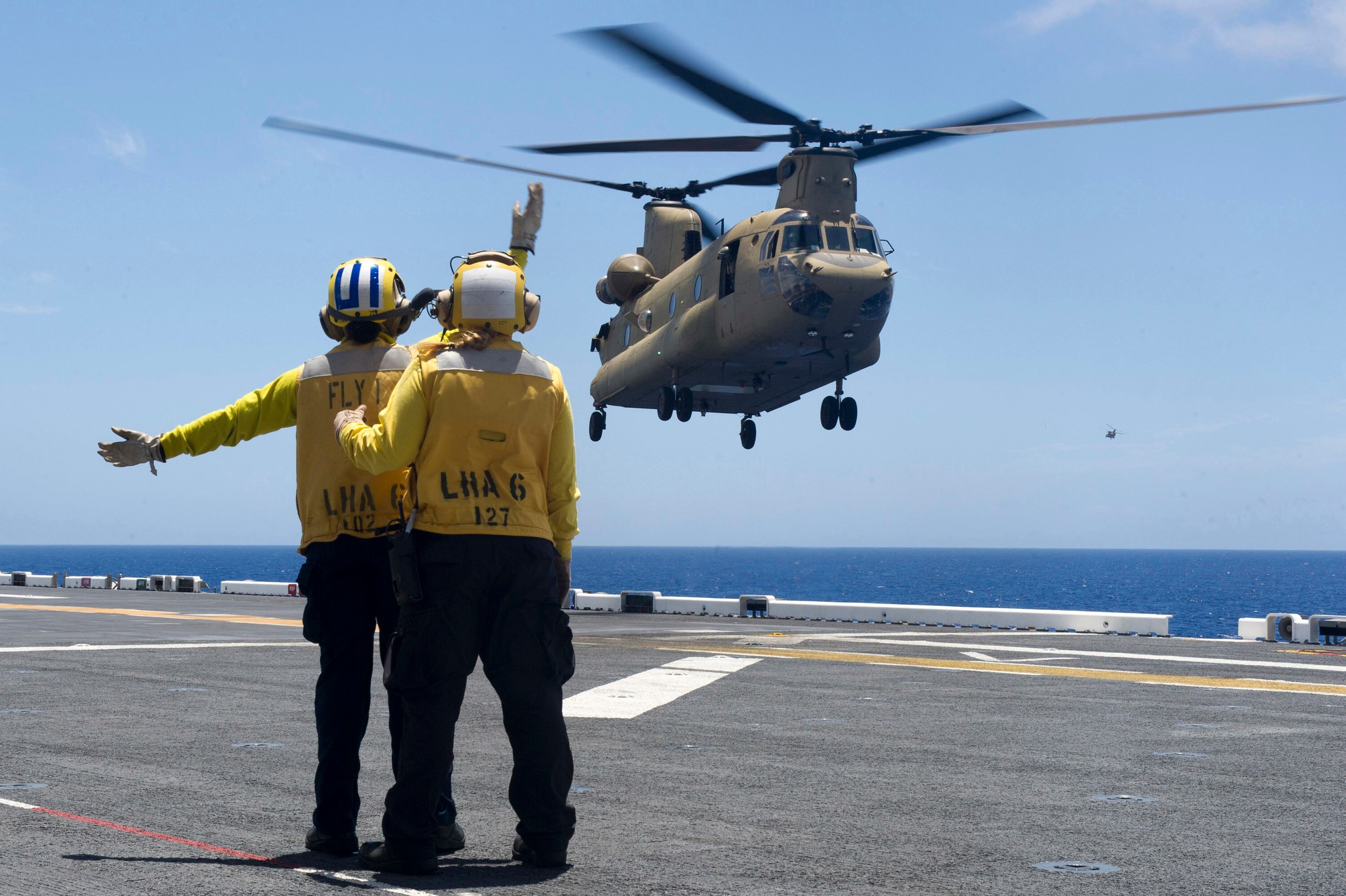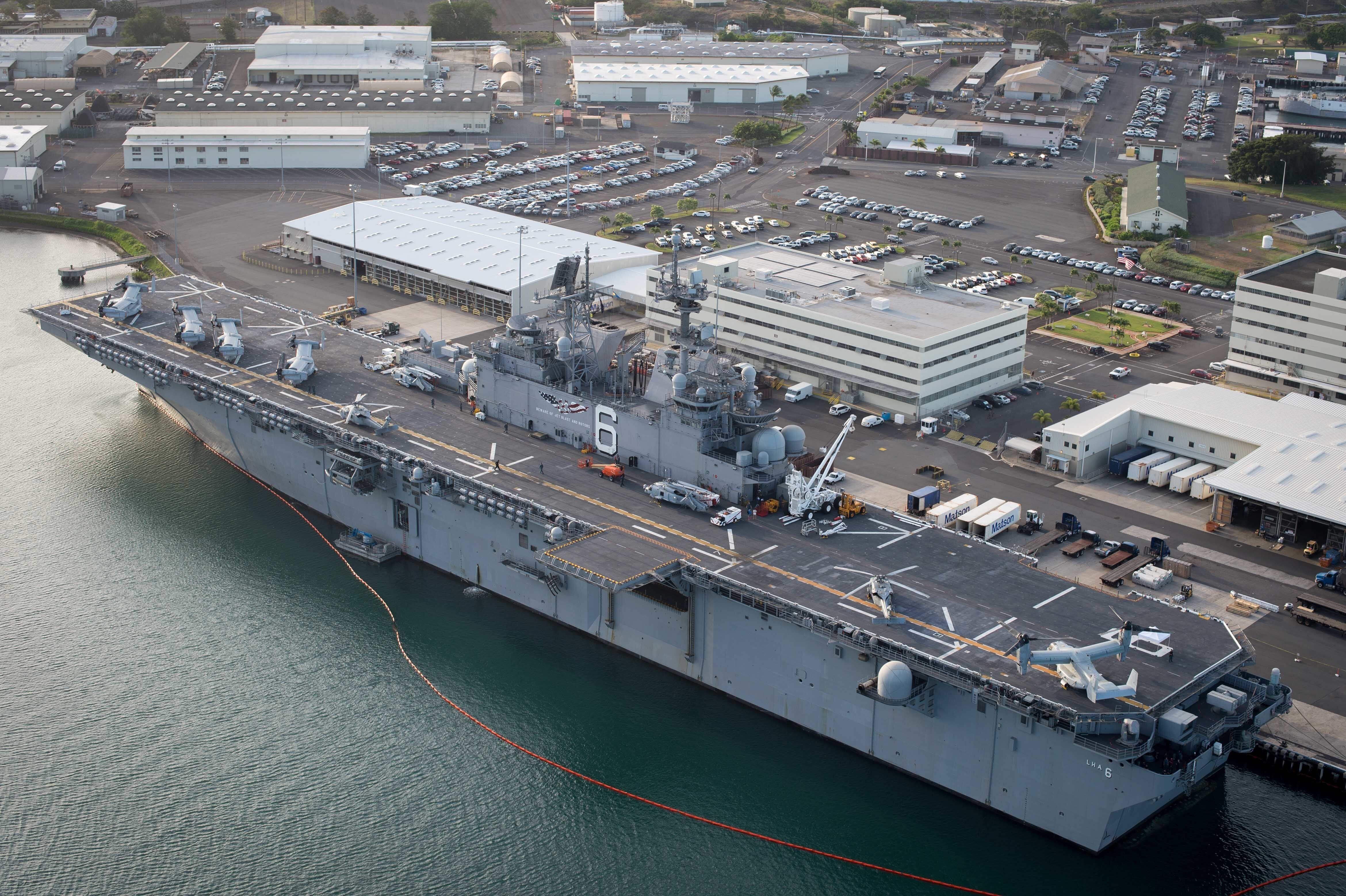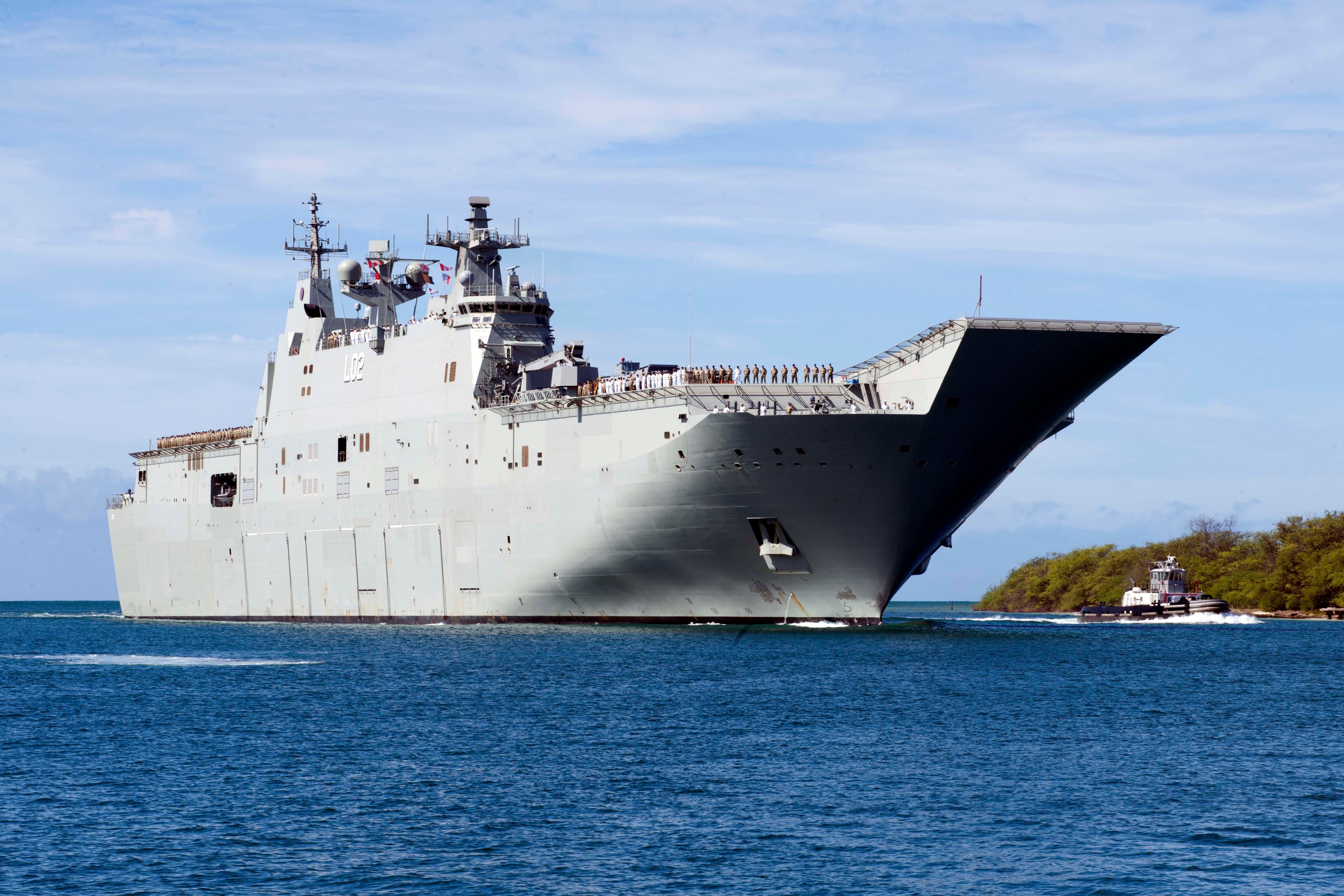Marines and sailors are training alongside their counterparts from China, Mexico and Australia and India over the next month as part of the world's largest maritime exercise in Hawaii and off the California coast.Right now, Marines in the Hawaiian Islands, off the coast of Southern California and elsewhere are taking part in this year’s Rim of the Pacific exercise, which is focused on integrating landing forces during amphibious operations, Marine Corps officials said.
As the world becomes more volatile, the Navy and Marine Corps are preparing to respond to crises in coastal regions with booming populations that could face severe instability in the event of a natural disaster, famine or dispute over resources. This year's Rim of the Pacific exercise, which includes 26 countries and 25,000 international troops, helps them prepare for these missions, said Brig. Gen. Ray Descheneaux, the cCommanding Ggeneral of Fleet Marine Forces for RIMPAC.16
"With a majority of [the globe's] that water dispersed in the Pacific, it is easy to understand why training with our combined partners in the Pacific is so important," Descheneaux told Marine Corps Times, noting that Marines and sailors have been tapped to respond to four disaster relief efforts in the region during the last six years. It is important for Marines in the Pacific to train for amphibious warfare because many parts of the world are becoming increasingly volatile due to disputes over natural resources, natural disasters and conflict, said Brig. Gen. Ray Descheneaux, the Commanding General of Fleet Marine Forces for RIMPAC16."Consider this: In the past six years, the 31st MEU [Marine Expeditionary Unit] has engaged in four disaster relief efforts including the Japanese earthquake in April 2016, Typhoon Soudelor in Saipan in 2015, Typhoon Haiyan in the Philippines in 2013, and the tsunami in Japan in 2011," Descheneaux told Marine Corps Times.
Exercises like RIMPAC allow the sea services and their allies to prepare for large-scale amphibious missions, even after former Defense Secretary Robert Gates raised the possibility that the days of Marines storming enemy beaches may be over.
"Looking ahead, I do think it is proper to ask whether large-scale amphibious assault landings along the lines of Inchon are feasible though anti-ship missiles with long range and high accuracy may make it necessary to debark from ships 25 or 40 or 60 or more miles at sea," Gates said in August 2010.
But Descheneaux said it's important for Marines and sailors to train for those events — especially as they test new high-tech tactics and gear.
"Suggesting that the Marines have not landed under fire since the Korean War is an interesting footnote," Descheneaux said. "Rather than suggesting the irrelevance of amphibious operations, it showcases progress in our technology, tactics, techniques and procedures."
Here's a look at what Marines and sailors will be up to during this year's exercise.
Storming Hawaiian beaches
This year’s exercise, which runs through lasts until Aug. 4, marks the first time that Marines will practice simultaneous amphibious operations in both Hawaii and Southern California at the same time, said Marine Maj. Timothy Tiller, U.S. Marine Forces Pacific lead RIMPAC planner for this year’s exercise.
Members of The 3rd Marine Regiment will lead is leading a multinational force that conducts extensive amphibious and landing force training around the Hawaiian Islands, he said. Tiller told Marine Corps Times.The other Marine units taking part include: in the training are 2nd Battalion, 3rd Marines; Marine Heavy Helicopter Squadron 463 and Combat Logistics Battalion 3, said Marine Corps spokeswoman 1st Lt. Natalie Poggemeyer.

Aviation boatswain's mates (handling) assigned to the amphibious assault ship America prepare a U.S. Army CH-47D Chinook helicopter for take-off during deck landing qualifications as the ship transits to Rim of the Pacific 2016.
Photo Credit: Navy
Training missions will include amphibious assaults, "Amphibious forcible entry operations will be rehearsed by conducting amphibious assaults, helicopter raids and seizures, and combined arms operations ashore," said Marine Corps spokeswoman 1st Lt. Natalie PoggemeyerPoggemeyer said. The 2nd Battalion, Royal Australian Regiment will contribute roughly half of the troops for the ground combat element, she added.
"This type of training at RIMPAC will integrate joint and combined capabilities to conduct amphibious, offensive, defensive, and stability operations," Poggemeyer said.The 2nd Battalion, Royal Australian Regiment will contribute roughly half of the troops for the ground combat element, she said.
California raids
The 15th Marine Expeditionary Unit is leading a second multinational force training in conducting extensive amphibious training off Southern California’s coast along with elements of 3rd Battalion, 5th Marines; Marine Light Attack Helicopter Squadron 369 and Combat Logistics Battalion 15, officials said.
The Marines and other troops will complete "The amphibious portion of the training in Southern California will include a variety of partnered operations including amphibious assaults, raids, non-combatant evacuation operations, and combined-arms training at ranges at on Camp Pendleton and San Clemente Island, Poggemeyer said.
There will also be Training on Camp Pendleton will include artillery and small-arms live-fire events, she added. as well as aerial gunnery and integrated MAGTF operations."
Testing new gear at the Stumps
Meanwhile, the Marine Corps Warfighting Laboratory will conduct a company landing team-sized experiment the Marine Air Ground Task Force Integrated Experiment at Twentynine Palms, California, to test the company landing team's operational concept Expeditionary Force 21, she said.
A small team from 3rd Battalion, 5th Marines will conduct live-fire exercises to simulate landing more than 120 miles from its sea base to fight insurgents backed by a major world power, according to officials with Marine Corps Combat Development Command.
The Marines will test their communications networks and other technologies as well as the concepts of how to use robotic systems and guided munitions in an urban environment.
While the experiment is not aimed at a specific adversary, the Marine Corps envisions future enemies will use electromagnetic warfare and cyber attacks, similar to how the Russians have fought in Eastern Ukraine.

People's Republic of China People's Liberation Army replenishment ship Gaoyouhu arrives at Joint Base Pearl Harbor-Hickam for Rim of the Pacific 2016.
Photo Credit: Petty Officer 1st Class John Her/Navy
Working with China
China is sending five ships to RIMPAC 16, one more ship than they sent to the last exercise two years ago, said Navy Lt. Lenaya Rotklein. The People’s Liberation Army is also sending a dive unit that consists of about 20 personnel, she said.
The Chinese ships will be part of Combined Joint Task Force 175, led by the Coast Guard Cutter Stratton, Rotklein said.
"During the exercise, PLA units will conduct medical exchanges, counter-piracy and maritime interdiction operations, diving operations, gunnery exercises and a submarine rescue event," she said.
Two years ago, the Chinese reportedly sent an uninvited spy ship to RIMPAC. A question for this year is how many of the Chinese sailors taking part in the exercise specialize in electronic warfare, military intelligence, and radar and electronic warfare, said Dean Cheng, of the Heritage Foundation think tank in Washington, D.C. The question is whether the Chinese will send another surveillance ship this year or have one of the five ships to collect intelligence, said Dean Cheng, of the Heritage Foundation think tank in Washington, D.C.
"You can tweak and modify ships to do information gathering if you’ve got the phased arrays, you certainly have the ability to emit signals and if you have the right antennae, you can certainly collect signals," Cheng said. Another question if any of the Chinese sailors specialize in electronic warfare, military intelligence, and radar and electronic warfare.
Despite sending a spy ship to RIMPAC in 2014, China feels the U.S. owes it an invitation to all subsequent exercises, Cheng said. The Chinese feel that — as the stronger nation — because it feels the U.S. has an obligation as the stronger nation to reassure China them that it harbors no hostile intentions toward the country, Cheng added. Cheng said. The Chinese believe that the U.S. has an obligation as the stronger nation to reassure them that it harbors no hostile intentions toward China.
"Their attitude, partly understandable, is: If I have a knife and you have a gun, transparency does not serve my ends," Cheng said. "However, since you have a gun and I have a knife, it is up to you to make me feel better — especially since I, self-evidently, am obviously not a threat to anyone."
Building partnerships
A total of 26 countries are taking part in RIMPAC 16 including Australia, India and China. The Mexican amphibious ship ARM Usumacinta will conduct amphibious training with the dock landing ship Pearl Harbor off California, Tiller said.
For the first time, an Australian amphibious ship, HMAS Canberra, will be part of the amphibious task force in Hawaii along with its U.S. counterparts: the amphibious assault America and amphibious transport dock San Diego, he said.

An aerial view of the amphibious assault ship America moored at Joint Base Pearl Harbor-Hickam for Rim of the Pacific 2016.
Photo Credit: Petty Officer 1st Class Ace Rhea/Navy
About total of around 420 Australian soldiers army personnel will be aboard embarked on the Canberra, according to Australian defense officials. including the 2nd Cavalry Regiment, 3rd Combat Engineer Regiment, 3rd Combat Service Support Battalion, 10th Force Support Battalion and 1st Close Health Battalion, an Australian defense spokesperson told Marine Corps Times.
"Interoperability and practical bilateral cooperation between the Australia army and the U.S. Marines develops both our nation's capabilities and enables us to work closely together when responding to regional and global security challenges," who spoke on the spokesperson said.
The military-to-military relationship between the U.S. and Australia is expanding growing, said Carl Baker, a defense analyst with the Center for Strategic and International Studies.
Australia is the anchor of the southern part of what Australian defense officials call the "Indo-Pacific region," which encompasses the Indian Ocean and South Pacific, said Baker, director of programs at Pacific Forum CSIS in Honolulu.
"It basically ties the Middle East to East Asia," Baker said. "That involves Europe. It involves all of the goods that are coming through the Suez [Canal] to Asia."

Royal Australian Navy ship HMAS Canberra arrives at Joint Base Pearl Harbor-Hickam for Rim of the Pacific 2016.
Photo Credit: Petty Officer 2nd Class Jeffrey/Navy
The U.S. supports the Australian concept of both nations working with India to patrol the Indian Ocean, Baker said.
"I think the U.S. has been very eager to improve the coordination between the U.S. and Australia – as well as the U.S. and India – through that particular body of water," Baker said.
Baker believes that military cooperation between the U.S. and India will be limited to both countries navies for the time being. The two countries already take part in the annual Exercise Malabar along with Japan.
While the U.S., Australia and India are focuses on the Southern Pacific and Indian Ocean, it is possible that the three countries may expand patrols to include the South China Sea, where China has overlapping territorial claims with U.S. partners and allies, Baker said.
"I don't think that's going to happen right away but India has been working with Vietnam in the South China Sea, and so it would make sense that eventually the United States, Australia and India will work in the South China Sea," he said. "I think for now, it would be down in the Indo-region and maybe the Indo-Pacific rather than going into the South China Sea, just because it's provocative to the Chinese at this point."
Amphibious operations still matter
Even though weaponry used to defend enemy coasts has advanced significantly since World War II, amphibious operations are still an important part of how Marines and sailors operate, said retired Marine Col. David Fuquea, a professor at the U.S. Naval War College.
With 70 percent of the Earth's surface covered in water, the U.S. military will continue to need to launch operations from the sea to take the fight to the enemy, Fuquea said.
"The Marine Corps has been saying — really since I was a captain back in the '80s and '90s — we can't think of amphibious operations in terms of the amphibious assaults like Iwo Jima," he said. "We want to use maneuver from the sea to go where the bad guy is not.
"When we start talking about the Wwestern Pacific and the Asian-Pacific region, the amphibious operation becomes an incredibly powerful tool because whoever it is we may be confronted by in that Wwestern Pacific region can't fortify, can't defend, can't prevent us from going everywhere."
In July 2006, Hezbollah severely damaged an Israeli corvette with an anti-ship missile, showing that amphibious assault ships must launch troops far from shore. Some of the technology used to put Marines ashore has evolved since World War II to meet new threats, Fuquea said. Other technology has not advanced at all, he said.
While the MV-22B Osprey and Landing Craft Air Cushions give the Marine Corps the ability to launch troops and vehicles far from shore, the Marines' amphibious vehicles and the Navy's next generation landing craft still move at between six and eight knots — the same speed as they did 70 years ago, Fuquea said.
"We're choosing some new systems that are no better than the legacy systems they are replacing, and that is the biggest thing that has to be overcome," he said. "Once you can do ship-to-shore and give yourself legitimate over-the-horizon capability, that ability to place large scale combat power anywhere we want from the over horizon at sea gives us maneuverability that can't be matched."





